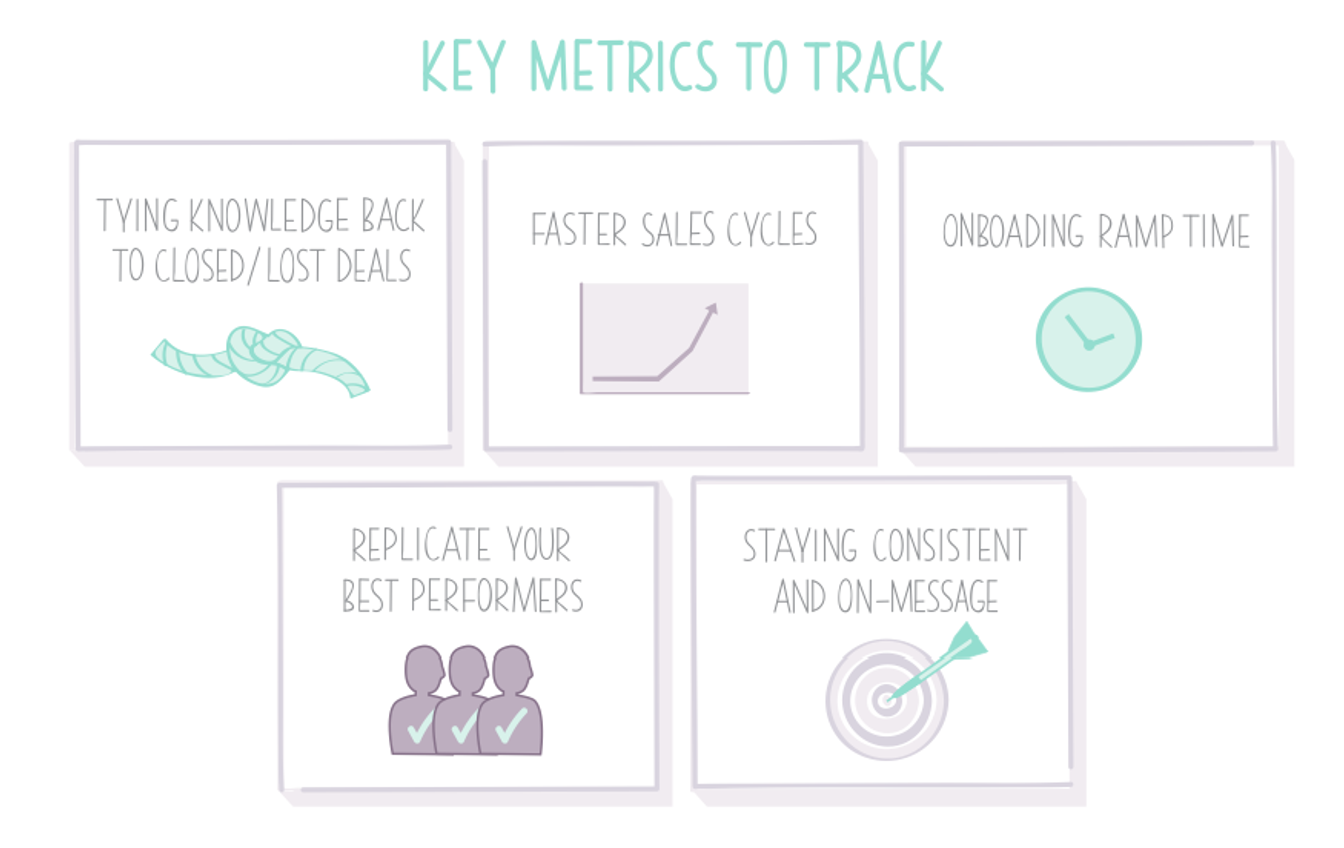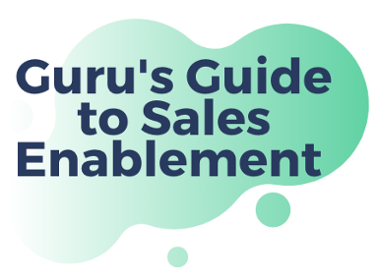5 Key Sales Enablement Metrics to Track Sales Performance
あなたの解決策がビジネスKPIにどのように影響を与えているかを確認するための5つの重要な営業支援メトリクスを追跡してください。 Guruから営業成功を測定する方法について詳しく学ぶ
セールスエンエーブルメントを構成する特定の戦術、機能、またはタスクは実際に存在しません。
イートは、新人研修、コンテンツ作成、知識管理、セールスサイクルなど、日常業務を最適化するために作成されたさまざまなツールとリソースを包括します。
1つに合うものがすべてに合うわけではない、というフレーズは、セールスエンエーブルメントソリューションに非常に適用されると思います。 すべてのビジネスやチームには独自のニーズがあり、そのため、セールスリーダーは組織と互換性のあるソリューションを選択します。
(だからこそ、すべてのビジネスには独自のセールスエンエーブルメントツールがある)
しかし、セールスエンエーブルメントの主な目的は常に同じです: 取引を締結するために売り手に必要なすべてを装備すること。
Guruを試してみてください。
無料で始める
それをどのようにすればいいですか? 基本的に、代理人に顧客を引きつける適切なスキル、方法、行動を提供し、効果的な知識基盤とコミュニケーションの容易な方法を提供し、一貫性を保ち、メッセージを伝えることなどが含まれます...
たぶん、今までに完璧なツールを見つけるためにかなりの時間とお金を費やしてきたかもしれません。 おそらく、エンエーブルメントツールに成功し、業績が向上しているかもしれません。 または、おそらく、チームはまだ取引を成立させることに苦労しているかもしれません。 いずれにせよ、セールスエンエーブルメントのROIを測定することは難しいかもしれません。
多数のセールスエンエーブルメントツールを所有できる能力は素晴らしいです! しかし、どのツールが実際に効果的であるかをどのように判断すればよいですか? さらに重要なのは、毎月無駄にしているツールがどれなのかを見極めるには、どのようにして調べるかですか?
解決策は、いくつかの重要なメトリクスを追跡することです。
追跡すべきメトリクスを知ると、有益なツールと無駄なツールを選別することは非常に簡単になります。
**あなたがセールスエンエーブルメントツールの実際の効果をどのように判断するかを支援するいくつかのメトリクスは次のとおりです:
知識をクローズド取引または失敗した取引に結び付ける
これが至福です。 多くの企業にはこのデータがありませんが、CRMデータと組み合わせて利用されるセールスエンエーブルメントソリューションが、クローズド取引または失敗した取引にどのような知識が導いたかをストーリーテリングします。 Slack統合の技術的側面に関する知識が一貫してクローズド取引につながっていることを発見すると想像してみてください。 このデータから、Slack統合に関する素敵にデザインされたワンページを作成して、顧客に送信できるよう代理人に渡すことができます。 SDRのリード獲得のために、Slackを使用している企業をターゲットにすることができます。 最後に、見込み客に最も共感している特定の知識とコンテンツをよりよく知ることで、貴重な材料を作成することにより、セールスチームと組織全体の両方をよりよくエンエーブルすることができます。 セールスサイクルを短縮する
より速い販売サイクル
貴社の販売サイクルはどのくらい速いですか? ベストインクラスのセールスエンエーブルメントソリューションは、この重要なメトリックについて説得力のあるストーリーを伝えることができます。 グルーの2つの主要な機能を活用することで、チームはセールスサイクルの時間を短縮できます。私たちの信頼検証エンジンとブラウザ拡張機能。 リプが使用しているコンテンツが正確であると信頼できれば、専門家からの回答を待つ必要はありません。 そうすることで、リプが電話中に見込み客の質問に答え、フォローアップのメールではなく直接行動します。 さらに、セールスエンエーブルメントソリューションが目的地でなく、CRMなどのツールと統合されている場合、情報を検索する時間が短縮されます。 これらの小さな利益はチーム全体に迅速に蓄積され、成約にかかる「やりとり」の時間を短縮する機会が増えると、セールスチームの速度が向上します。
オンボーディングのランプ時間
新しいセールスリプをオンボーディングするスピードはどのくらいですか? 以前の記事で述べたように、新しいセールスリップの採用とオンボーディングには平均で7ヶ月とほぼ30,000ドルかかります。追加で、リップが完全にスタートアップするまで5〜11ヶ月かかります。 正直に言って、それは長すぎます。 これを効果的に計測するためには、セールスエンエーブルメントソリューションを展開する前と後で、同時に雇用されたリップのコホートを比較する必要があります。 新しいクラスやリップが平均してグループで向上していない場合、ソリューションの影響と個々のリプのスキルレベルの違いを区別するのは不可能です。 各クラスがランプアップする能力に影響を与える変数が数多くありますが、セールスエンエーブルメントソリューションを実装するに従い、この成功メトリックの累積平均値は上昇傾向にあるはずです。
もし新しいセールスリプが以前かかっていた時間の半分で取引を締結し始めるようになったら、貴社の収益数値にどのような意味がありますか?
優れた成績者を複製する
すべてのセールスチームには、常にノルマをクリアし続け、うまく見せるエースプレーヤーがいます。 彼らがうまくパフォーマンスを発揮する多くの理由がありますが、その1つは見込み客に購入を促すために何を伝えるかを理解していることです。 セールスエンエーブルメントソリューションを使用すると、リプが使用するコンテンツのすべての使用状況をキャプチャして追跡できるため、これについて推測する必要はもうありません。 その効果的なコンテンツを他のセールスチームメンバーに強調して伝えることで、彼らのゲームを向上させることができます。
一貫したメッセージとメッセージの維持
セールスチームのメッセージングの一貫性の欠如は取引を妨げることができます。 さらに悪いことに、セールスチーム内のメッセージの一貫性は、新規顧客に非現実的な期待を抱かせる可能性があり、彼らが素早く脱退する原因となり、チームが成功させようと投資した貴重な時間を無駄にします。 セールスエンエーブルメントソリューションをチームの「真実の唯一の情報源」として作成することにより、見込み客に話しかける際にチームを一貫してメッセージを伝えることができます。 例えば、データを分析して、特定の業界ケーススタディが見込み客と非常によく共感していることがわかりました。 貴社のソリューションが直接CRMに統合されているため、機会レコードを開くとケーススタディがチームに表示されます。 今、チームのすべてのメンバーが、見込み客によく共感する資産を送信しており、マーケティングチームは、自分たちが作成したアセットを使用していることを知って満足しています。 それはwin-winです。
さらに学ぶために、Guruのセールスエンエーブルメントガイドをチェックしてください:
貴社のセールスエンエーブルメントの成功を測定するために追跡する主要メトリックは何ですか? Twitterで知らせる
セールスエンエーブルメントを構成する特定の戦術、機能、またはタスクは実際に存在しません。
イートは、新人研修、コンテンツ作成、知識管理、セールスサイクルなど、日常業務を最適化するために作成されたさまざまなツールとリソースを包括します。
1つに合うものがすべてに合うわけではない、というフレーズは、セールスエンエーブルメントソリューションに非常に適用されると思います。 すべてのビジネスやチームには独自のニーズがあり、そのため、セールスリーダーは組織と互換性のあるソリューションを選択します。
(だからこそ、すべてのビジネスには独自のセールスエンエーブルメントツールがある)
しかし、セールスエンエーブルメントの主な目的は常に同じです: 取引を締結するために売り手に必要なすべてを装備すること。
Guruを試してみてください。
無料で始める
それをどのようにすればいいですか? 基本的に、代理人に顧客を引きつける適切なスキル、方法、行動を提供し、効果的な知識基盤とコミュニケーションの容易な方法を提供し、一貫性を保ち、メッセージを伝えることなどが含まれます...
たぶん、今までに完璧なツールを見つけるためにかなりの時間とお金を費やしてきたかもしれません。 おそらく、エンエーブルメントツールに成功し、業績が向上しているかもしれません。 または、おそらく、チームはまだ取引を成立させることに苦労しているかもしれません。 いずれにせよ、セールスエンエーブルメントのROIを測定することは難しいかもしれません。
多数のセールスエンエーブルメントツールを所有できる能力は素晴らしいです! しかし、どのツールが実際に効果的であるかをどのように判断すればよいですか? さらに重要なのは、毎月無駄にしているツールがどれなのかを見極めるには、どのようにして調べるかですか?
解決策は、いくつかの重要なメトリクスを追跡することです。
追跡すべきメトリクスを知ると、有益なツールと無駄なツールを選別することは非常に簡単になります。
**あなたがセールスエンエーブルメントツールの実際の効果をどのように判断するかを支援するいくつかのメトリクスは次のとおりです:
知識をクローズド取引または失敗した取引に結び付ける
これが至福です。 多くの企業にはこのデータがありませんが、CRMデータと組み合わせて利用されるセールスエンエーブルメントソリューションが、クローズド取引または失敗した取引にどのような知識が導いたかをストーリーテリングします。 Slack統合の技術的側面に関する知識が一貫してクローズド取引につながっていることを発見すると想像してみてください。 このデータから、Slack統合に関する素敵にデザインされたワンページを作成して、顧客に送信できるよう代理人に渡すことができます。 SDRのリード獲得のために、Slackを使用している企業をターゲットにすることができます。 最後に、見込み客に最も共感している特定の知識とコンテンツをよりよく知ることで、貴重な材料を作成することにより、セールスチームと組織全体の両方をよりよくエンエーブルすることができます。 セールスサイクルを短縮する
より速い販売サイクル
貴社の販売サイクルはどのくらい速いですか? ベストインクラスのセールスエンエーブルメントソリューションは、この重要なメトリックについて説得力のあるストーリーを伝えることができます。 グルーの2つの主要な機能を活用することで、チームはセールスサイクルの時間を短縮できます。私たちの信頼検証エンジンとブラウザ拡張機能。 リプが使用しているコンテンツが正確であると信頼できれば、専門家からの回答を待つ必要はありません。 そうすることで、リプが電話中に見込み客の質問に答え、フォローアップのメールではなく直接行動します。 さらに、セールスエンエーブルメントソリューションが目的地でなく、CRMなどのツールと統合されている場合、情報を検索する時間が短縮されます。 これらの小さな利益はチーム全体に迅速に蓄積され、成約にかかる「やりとり」の時間を短縮する機会が増えると、セールスチームの速度が向上します。
オンボーディングのランプ時間
新しいセールスリプをオンボーディングするスピードはどのくらいですか? 以前の記事で述べたように、新しいセールスリップの採用とオンボーディングには平均で7ヶ月とほぼ30,000ドルかかります。追加で、リップが完全にスタートアップするまで5〜11ヶ月かかります。 正直に言って、それは長すぎます。 これを効果的に計測するためには、セールスエンエーブルメントソリューションを展開する前と後で、同時に雇用されたリップのコホートを比較する必要があります。 新しいクラスやリップが平均してグループで向上していない場合、ソリューションの影響と個々のリプのスキルレベルの違いを区別するのは不可能です。 各クラスがランプアップする能力に影響を与える変数が数多くありますが、セールスエンエーブルメントソリューションを実装するに従い、この成功メトリックの累積平均値は上昇傾向にあるはずです。
もし新しいセールスリプが以前かかっていた時間の半分で取引を締結し始めるようになったら、貴社の収益数値にどのような意味がありますか?
優れた成績者を複製する
すべてのセールスチームには、常にノルマをクリアし続け、うまく見せるエースプレーヤーがいます。 彼らがうまくパフォーマンスを発揮する多くの理由がありますが、その1つは見込み客に購入を促すために何を伝えるかを理解していることです。 セールスエンエーブルメントソリューションを使用すると、リプが使用するコンテンツのすべての使用状況をキャプチャして追跡できるため、これについて推測する必要はもうありません。 その効果的なコンテンツを他のセールスチームメンバーに強調して伝えることで、彼らのゲームを向上させることができます。
一貫したメッセージとメッセージの維持
セールスチームのメッセージングの一貫性の欠如は取引を妨げることができます。 さらに悪いことに、セールスチーム内のメッセージの一貫性は、新規顧客に非現実的な期待を抱かせる可能性があり、彼らが素早く脱退する原因となり、チームが成功させようと投資した貴重な時間を無駄にします。 セールスエンエーブルメントソリューションをチームの「真実の唯一の情報源」として作成することにより、見込み客に話しかける際にチームを一貫してメッセージを伝えることができます。 例えば、データを分析して、特定の業界ケーススタディが見込み客と非常によく共感していることがわかりました。 貴社のソリューションが直接CRMに統合されているため、機会レコードを開くとケーススタディがチームに表示されます。 今、チームのすべてのメンバーが、見込み客によく共感する資産を送信しており、マーケティングチームは、自分たちが作成したアセットを使用していることを知って満足しています。 それはwin-winです。
さらに学ぶために、Guruのセールスエンエーブルメントガイドをチェックしてください:
貴社のセールスエンエーブルメントの成功を測定するために追跡する主要メトリックは何ですか? Twitterで知らせる
Experience the power of the Guru platform firsthand – take our interactive product tour
見学する







